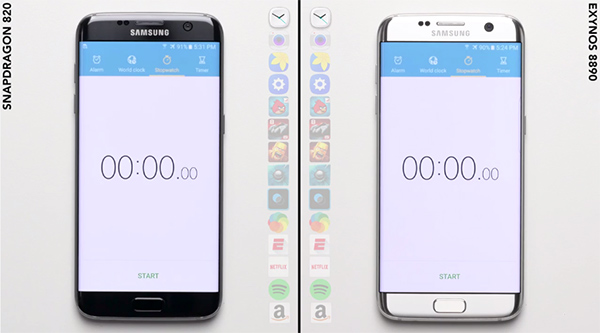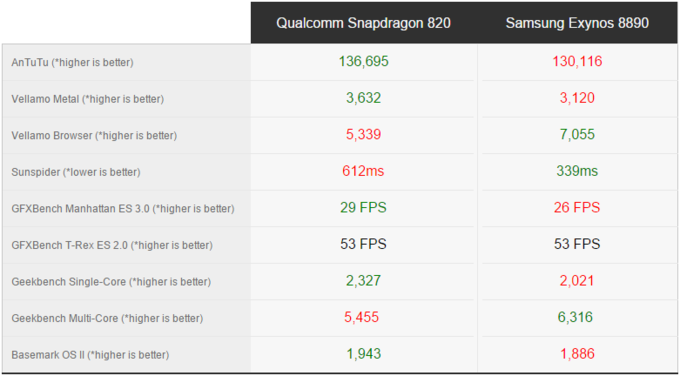The Galaxy S7 and S7 Edge are a little different depending on where you buy them. Customers in the United States and China (CDMA nations) will receive a version with the Snapdragon 820 CPU, while those in the rest of the world (including the UK) will get an Exynos version (GSM).
These different processors have different strengths and weaknesses, and you may find that you need to import a different model to ensure you get the loadout you want. Here’s a brief runthrough of the differences that have been discovered so far.
Specifications
| US VARIANT | INTERNATIONAL VARIANT | |
|---|---|---|
| PROCESSOR | Qualcomm Snapdragon 820 Quad-Core, 14 nm 2 x 1.59 GHz, 2 x 2.15 GHz |
Samsung Exynos 8890 Octa-Core, 14 nm 2 x 2.6 GHz or 4 x 2.3 GHz + 4 x 1.5 GHz |
| GRAPHICS CARD | Adreno 530, 624 MHz | Mali T880MP12, 650 MHz |
| MEMORY | Dual-Channel LPDDR4 1,866 MHz | Dual-Channel LPDDR4 1,794 MHz |
Qualcomm’s Snapdragon 820 CPU is the same processor that’s used in other leading flagships in 2016, including the LG G5, Xiaomi Mi 5 and Sony Xperia X Performance. (The HTC 10, scheduled to be announced in April, is also thought to come with the Snapdragon 820). It’s a quad-core processor, with two cores at 2.15GHz and two cores at 1.59GHz. It’s backed with an Adreno 530 GPU at 624MHz and dual-channel DDR4 RAM at 1.866MHz.
The Exynos 8890 debuts in the Galaxy S7 and S7 Edge, and is an octa-core CPU, with four cores at 2.3GHz and four cores at 1.5GHz. It’s backed with a faster GPU, the Mali T880MP12, clocked at 650 MHz, but slower 1794MHz DDR4 RAM.
Performance
In the Galaxy S7, the Snapdragon 820 appears to have faster single-threaded performance, while the Exynos 8890 does better in multi-core tests. PhoneArena‘s test suite showed the Exynos variant do better at web browsing tests, while the Snapdragon variant outperformed Exynos in harder gaming benchmarks. So far it’s a dead heat, but things are about to become a little unbalanced.
App speed & RAM management
In tests done by PhoneBuff, the Exynos-based phone also loads apps faster initially, and also keeps the apps in RAM for longer. This allowed t to instantly switch to apps in the second lap of the test rather than loading them from scratch, as the Snapdragon model did.
Considering there’s no difference in the total amount of RAM (and the Snapdragon variant has its RAM at a higher clock speed), it seems likely that the two phones use a very different strategy for managing RAM. It’s possible Samsung can improve this in the future with a patch, but for now the Exynos variant looks much stronger.
Battery Life
The two models also have stark differences when it comes to battery life. According to tests done by GSMArena, the Exynos model is again superior to its Snapdragon cousin, boasting two hours of additional talk time, three hours of extra video playback and three-and-a-bit hours of additional web browsing.
Conclusion
With one draw and two outright victories, the Eynos 8890 seems to be the better choice when it comes to choosing a chipset for the Galaxy S7 and S7 Edge. The results weren’t marginal either, suggesting that Samsung spent a lot more time optimising the Exynos variant than the Snapdragon model — or perhaps the Exynos chipset is simply superior. Either way, American and Chinese consumers might be wise to import a European model… as long as they’re planning to use their phones on a GSM network in their home countries.


